NITI Aayog released the fourth edition Sustainable Development Goals SDG India Index 2024 on 12th July 2024 for the FY 2023-24. A sustainable development index is the key report for measuring the progress made by the country in terms of global sustainable goals. It also reflects the progress and contribution made by each state or UT.
Below is the detailed index report by NITI Aayog for SDG India 2023-24 Index.
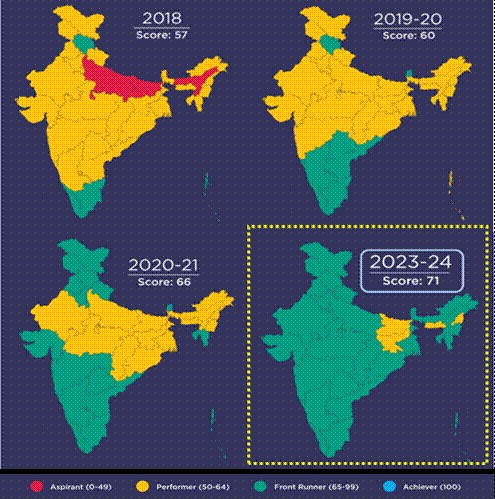
Key Highlights of SDG India Index 2024
- The composite score for India improved from 57 in 2018 to 66 in 2020-21 to further to 71 in 2023-24
- Significant progress in goals on eliminating poverty, providing decent work, economic growth, climate action and life on land.
- Targeted interventions by the Government such as Pradhan Mantri Awas Yojana, Ujjwala, Swachh Bharat, Jan Dhan, Ayushman Bharat-PMJAY, Ayushman Arogya Mandir, PM-Mudra Yojana, Saubhgaya, Start-up India etc. had impact and led to rapid improvement.
- All States have shown an improvement in overall score
- Overall SDG score for the country is 71 for 2023-24, significant improvement from 66 in 2020-21 and 57 in 2018 (Baseline report).
- Scores for States range from 57 to 79 in 2023-24, marking a substantial improvement from the year 2018 range of 42 to 69.
- Significant progress in Goals 1 (No Poverty), 8 (Decent Work and Economic Growth), 13 (Climate Action) and 15 (Life on Land)
- Goal 13 (Climate Action) records highest increase in score from 54 in 2020-21 to 67 in 2023-24 followed by Goal 1 (No Poverty) from 60 to 72
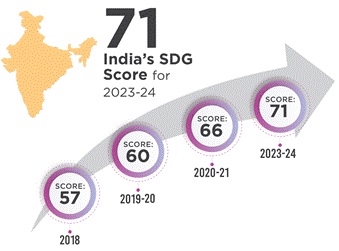
- 32 States and UTs in the front-runner category with 10 new entrants -Arunachal Pradesh, Assam, Chhattisgarh, Madhya Pradesh, Manipur, Odisha, Rajasthan, Uttar Pradesh, West Bengal, and Dadra and Nagar Haveli and Daman and Diu.
- Government’s focus on ensuring food & nutrition security, health, education, electrification, housing for all, sanitation, clean cooking fuel & energy has significantly contributed to the improvements.
SDG GOAL WISE PERFORMANCE – 2024
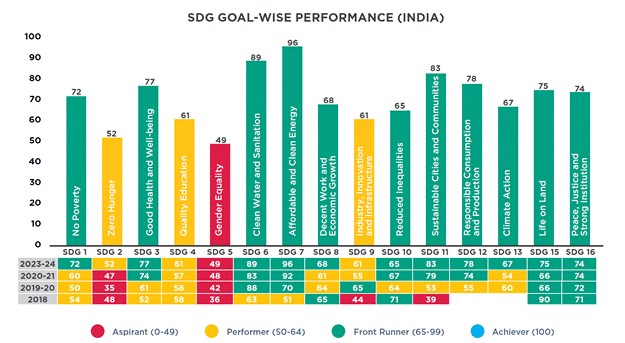
- Key interventions facilitating SDG achievements include:
- Over 4 crore houses under the PM Awas Yojana (PMAY),
- 11 crore Toilets & 2.23 lakh Community Sanitary Complexes in rural areas
- 10 crore LPG connections under PM Ujjwala Yojana,
- Tap water connections in over 14.9 crore households under Jal Jeevan Mission
- Over 30 crore beneficiaries under Ayushman Bharat -Pradhan Mantri Jan Arogya Yojana
- Coverage of over 80 crore people under the National Food Security Act (NFSA)
- Access to 150,000 Ayushman Arogya Mandir which offer primary medical care and provide affordable generic medicines
- Direct Benefit Transfer (DBT) of ₹34 lakh crore made through PM-Jan Dhan accounts.
- The Skill India Mission has led to over 1.4 crore youth being trained and upskilled and has reskilled 54 lakh youth
- PM Mudra Yojana sanctioned 43 crore loans aggregating to ₹22.5 lakh crore for entrepreneurial aspirations of the youth besides Funds of Funds
- Start Up India and Start Up Guarantee schemes assisting the youth
- The Saubhagya scheme for access to electricity
- Emphasis on renewable energy resulted in an increase in solar power capacity from 2.82 GW to 73.32 GW in the past decade.
- Between 2017 and 2023, India has added around 100 GW of installed electric capacity, of which around 80% is attributed to non-fossil fuel-based resource.
- Improvement in digital infrastructure with reduced internet data costs by 97% which has in turn positively affected and fostered financial inclusion
SDG India Index 2023-24 measures and tracks national progress of all States and UTs on 113 indicators aligned to the Ministry of Statistics and Programme Implementation’s (MoSPI) National Indicator Framework (NIF). The SDG India Index computes goal-wise scores on the 16 SDGs for each State and UT.
India’s commitment to the SDGs since adopting the 2030 Agenda on Sustainable Development is reflected in concerted efforts on SDG localization spearheaded by NITI Aayog, which works closely with States and UTs. NITI Aayog has the twin mandate to oversee the adoption and monitoring of the SDGs in the country.
The SDG India Index has been consistently improved over the years to provide a comprehensive and comparative analysis of progress on the goals. By fostering collaborative competition, the Index not only highlights achievements, but also encourages States and UTs to learn from each other to close outcome-based gaps. Grounded in the globally accepted SDSN methodology, the development of the Index followed extensive consultations with the States and UTs (the primary stakeholders); MoSPI; Union Ministries; and UN agencies. The Index represents the articulation of the comprehensive nature of the Global Goals under the 2030 Agenda while being attuned to the national priorities.
Sustainable Development Goals SDG India Index 2024 – State wise Rankings
SDG India Index 2024 – State Wise Ranking list and Score
- Uttarakhand – 79
- Kerala – 79
- Tamil Nadu – 78
- Goa – 77
- Himachal Pradesh – 77
- Punjab – 76
- Sikkim – 76
- Karnataka – 75
- Gujarat – 74
- Andhra Pradesh – 74
- Telangana – 74
- Maharashtra – 73
- Mizoram – 72
- Haryana – 72
- Manipur – 72
- Tripura – 71
- West Bengal – 70
- Rajasthan – 67
- Madhya Pradesh – 67
- Uttar Pradesh – 67
- Chhattisgarh – 67
- Odisha – 66
- Assam – 65
- Arunachal Pradesh – 65
- Meghalaya – 63
- Nagaland – 63
- Jharkhand – 62
- Bihar – 57
SDG India Index 2024 -Union Territory Wise Ranking and Score
- Chandigarh – 77
- Jammu & Kashmir -74
- Puducherry – 74
- Andaman & Nicobar Islands – 70
- Delhi – 70
- Dadra & Nagar Haveli & Daman & Diu – 66
- Lakshadweep – 66
- Ladakh – 65
State and UT Results – SDG India Index 2024:
- The SDG India Index 2024 for the FY 2023-24 reports a positive trend in the performance of States and UTs in their SDG journey. The scores for States now range from 57 to 79, while UTs score between 65 and 77. This represents an improvement over the 2020-21 scores, where the range was 52 to 75 for States and 62 to 79 for UTs.
The performance of State and UTs in terms of their overall score is given below:
- The Index records a significant increase in the number of States and UTs achieving
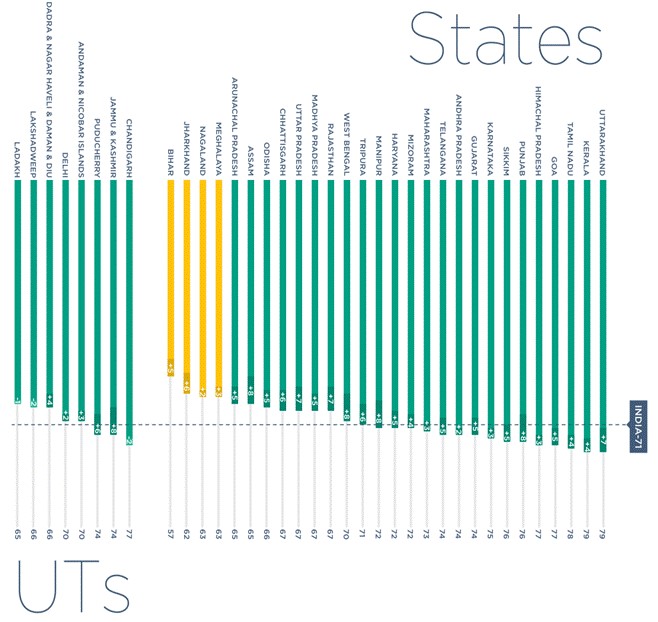
- Front Runner status. This year, 32 States/UTs have scored between 65 and 99, up from 22 in the 2020-21 edition. Notably, there are 10 new States and UTs in the Front Runner category. These include Arunachal Pradesh, Assam, Chhattisgarh, Madhya Pradesh, Manipur, Odisha, Rajasthan, Uttar Pradesh, West Bengal, and Dadra and Nagar Haveli and Daman and Diu.
- The SDG India Index 2023-24 demonstrates the increase in composite scores across all States, with improvements ranging from 1 to 8 points. Leading the way in terms of score improvement are Assam, Manipur, Punjab, West Bengal, and Jammu and Kashmir, each achieving a positive change of 8 points since the 2020-21 edition.
- Index methodology:
- The methodology of the Index involves a series of steps. The first step consists of compiling raw data for the selected indicators and identifying data gaps (if any). Subsequently, target values for 2030 are established for each indicator, providing clear benchmarks for evaluating progress. The raw data is then normalised, transforming it into a score ranging from 0 to 100. The Goal score for each SDG is computed by taking the arithmetic mean of the normalized scores of its relevant indicators. The composite SDG India Index score is derived as an average of all Goal scores. The index and indicators are updated incorporating the latest developments in data availability.
- Goal 14 has not been included in the calculation of the Composite Score for the Index as it solely pertains to the nine coastal States.
- The SDG India Index 2023–24 is also live on an online dashboard. The dashboard provides user friendly visualizations to identify crucial development outcome based gaps at the national and subnational levels.
- NITI Aayog has the mandate for coordinating the adoption and monitoring of SDGs at the national and sub-national levels.
- The results demonstrated in the Index are not only significant at the national and subnational levels, but have the potential to inform other countries in their pursuit of accelerating progress on the SDGs. This is due to the sheer scale of transformation brought forth through focused interventions and schemes in India which provide valuable lessons for the rest of the world.
- NITI Aayog is committed to supporting all the States and UTs in the localisation and acceleration of SDGs, an important barometer to measure progress towards Viksit Bharat @ 2047. The SDG India Index stands as a key milestone for measuring our progress and will help steer discussions, deliberations, and decisions in the journey ahead.
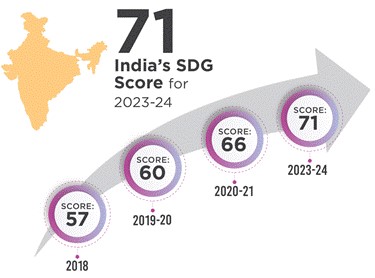
- The Goal wise progress of states since the baseline is given below
GOAL WISE RESULTS 2024 – SDG India Index 2024
Goal 1 – No Poverty
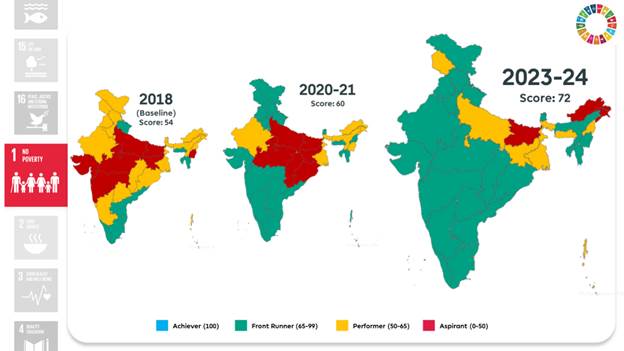
Goal-1 (No Poverty) improved by 12 points from 2020-21 (Index 3) to 2023-24 (SDG India Index 2024 – Index 4), advancing from Performer to Front Runner category.
- Multidimensional poverty nearly halved from 24.8% to 14.96% between 2015-16 and 2019-21.
- Multidimensional poverty for 2022-23 further likely dropped to 11.28%, with 24.8 crore people moving out of multidimensional poverty between 2013-14 and 2022-23.
- 99.7% were offered employment of the persons demanding employment under MGNREGA in 2023–2024.
- 95.4% households live in pucca/ semi-pucca houses as per NFHS-5 (2019-21).
- 41% of households have at least one member covered under health insurance or health scheme as per NFHS-5 (2019-21), an improvement from 28.7% in NFHS -4 (2015-16).
Goal 2 – Zero Hunger
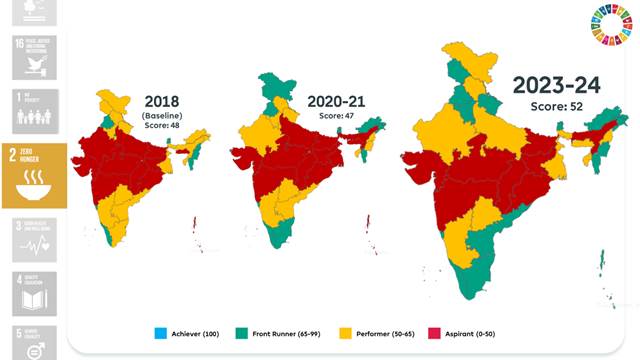
Improvement in overall composite score of Goal 2 moving from Aspirant category in SDG India Index 3 (2020-21) to Performer category in the SDG India Index 4 (2023-24)
- 99.01% of beneficiaries covered under National Food Security Act (NFSA), 2013
- Improvement in productivity of rice and wheat from 2995.21 kg/ha in 2018-19 to 3052.25 kg/ha in TE 2021-22
- Increase in Gross Value Added (GVA) (constant prices) in agriculture per worker from ₹ 0.71 lakhs in 2018-19 to ₹ 0.86 lakhs in 2022-23
Goal 3- Good Health and Well-being

- Overall score improved substantially from 52 in 2018 to 77 in 2023-24
- Maternal Mortality Rate per 1,00,000 live births stand at 97
- Reduced under 5 mortality rate (per 1,000 live births) from 36 in 2016-18 to 32 in 2018-20.
- 93.23% children aged 9-11 months are fully immunized
- 87.13% tuberculosis cases notified against target
- 97.18% of total deliveries reported in health institutions
SDG 4 – Quality Education
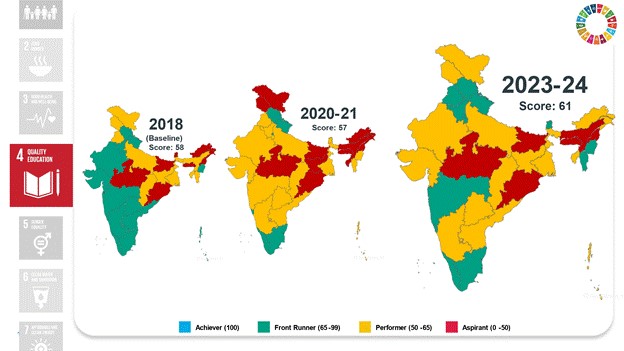
- Adjusted Net Enrolment Rate (ANER) for elementary education is 96.5% for 2021-22, up from 87.26% in 2018-19, with 14 States and UTs achieving 100%.
- Pupil Teacher Ratio is 18 for 2021-22, thus achieving the target of 30.
- 88.65% of schools have access to both electricity and drinking water.
- 100% parity between females and males in Higher Education (18-23 years)
Goal 5 – Gender Equality
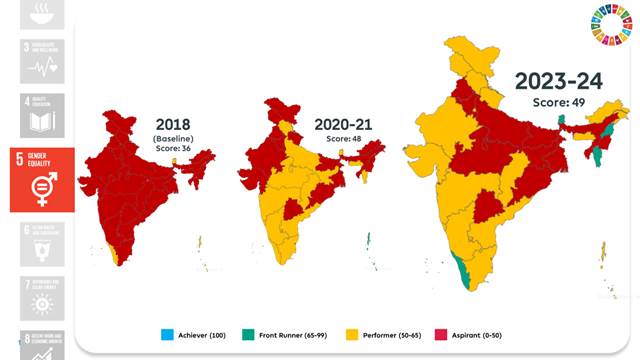
- Overall score improved significantly from 36 in 2018 to 49 in SDG India Index 2024 (203-24).
- Sex ratio at birth (females per 1,000 males) stands at 929
- Improved ratio of female to male earnings (regular waged salaried employees) from 0.74 in 2018-19 to 0.76 in 2022-23
- Improved ratio of female to male Labour Force Participation Rate (LFPR) (15-59 years) from 0.33 in 2018-19 to 0.48 in 2022-23
- 74.1% of married women have their demand for family planning met by any modern method as per NHFS -5.
- 53.90% of women own a mobile phone that they themselves use (aged 15-59 years) as per NHFS -5.
- 88.70% of married women participate in three household decisions as per NHFS -5.
SDG 6 -Clean Water and Sanitation
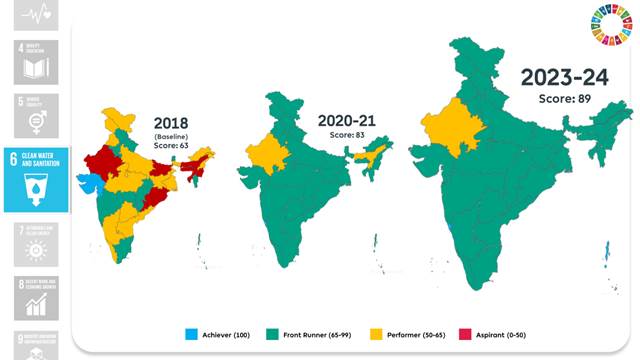
- Significant improvement in score from 63 in 2018 to 89 in 2023-24
- All individual household toilets have been constructed against target and all districts have verified to be ODF under SBM(G).
- 99.29% of rural households have improved their source of drinking water.
- 94.7% of schools have functional toilets for girls.
- Overexploitation in blocks/mandals/taluks has reduced from 17.24% in 2017 to 11.23% in 2022.
Goal 7 – Affordable and Clean Energy
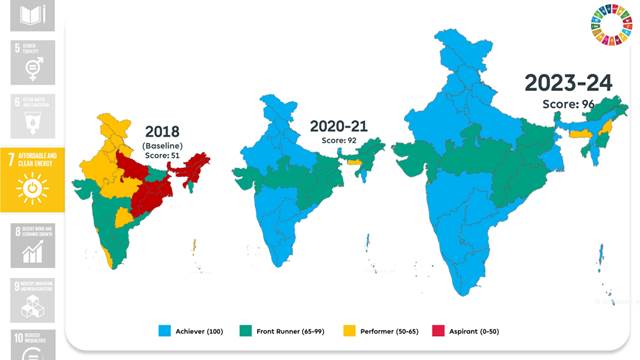
- Highest score amongst all SDGs also significant improvement from 51 in 2018 to 96 in 2023-24
- 100% households have access to electricity under Saubhagya Scheme.
- Significant improvement in households have clean cooking fuel (LPG + PNG) connections from 92.02% (2020) to 96.35% (2024)
Goal 8 – Decent Work and Economic Growth

- 5.88% of annual growth rate of India’s GDP per capita at constant prices in 2022–2023
- Reduction in unemployment rate (15-59 years) from 6.2% in 2018-19 to 3.40% in 2022-23
- Increased Labour Force Participation Rate (LFPR) (%) (15-59 years) from 53.6% in 2018-19 to 61.60% in 2022-23
- 95.70% of households have one member with a bank or post office account
- 55.63% of accounts in Pradhan Mantri Jan Dhan Yojana (PMJDY) are held by women
SDG 9 – Industry, Innovation and Infrastructure

- Improvement in score from 41 in 2018 to 61 in 2023-24(SDG India Index 2024)
- 99.70% of all targeted habitations are now connected with all-weather roads under Pradhan Mantri Gram Sadak Yojana, an improvement from 47.38% in 2017-18.
- 93.3% of households own atleast one mobile phone.
- 95.08% of villages have 3G/4G mobile internet coverage.
Goal 10 – Reduced Inequalities
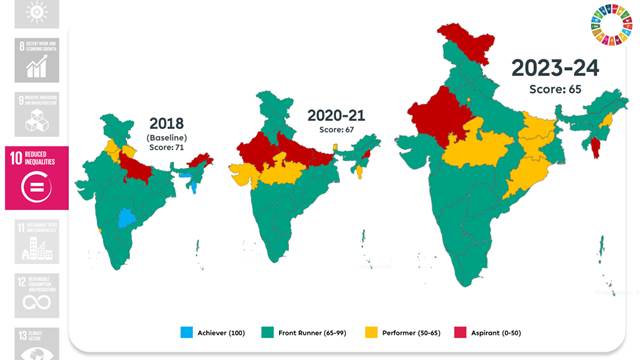
- 45.61% seats of Panchayati Raj Institutions held by women.
- 28.57% representation of SC/ST persons in state legislative assemblies.
SDG 11 – Sustainable Cities and Communities
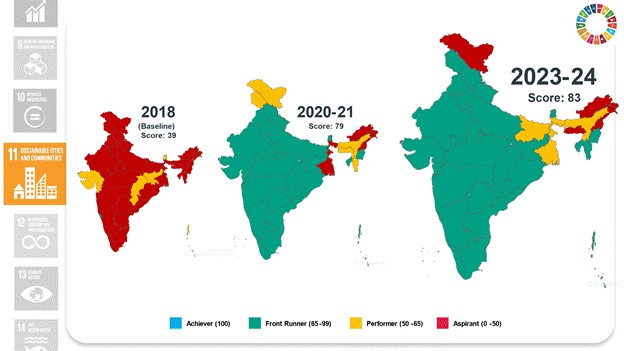
- Significant improvement in score from 39 in 2018 to 83 in 2023-24(SDG India Index 2024).
- Installed sewage treatment capacity as a percentage of sewage generated in urban areas has increased from 38.86% in 2018 to 51% in 2020-21.
- The percentage of municipal solid waste processed has increased from 68% in 2020 to 78.46% in 2024.
- 97% of wards have 100% door to door waste collection.
- 90% of wards have 100% source segregation under SBM (U).
Goal 12 – Responsible Consumption and Production
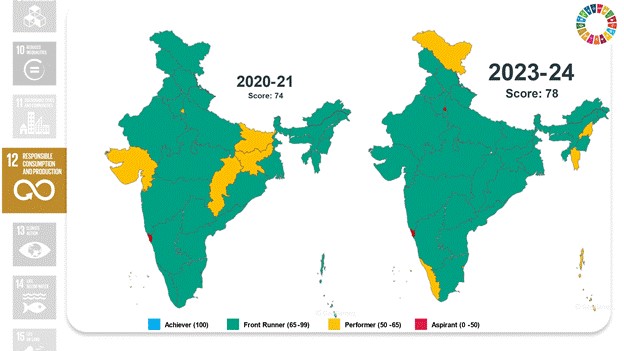
- 91.5% of biomedical waste generated is treated in 2022.
- 54.99% hazardous waste recycled/utilized of total hazardous waste generated in 2022-23– an increase compared to 44.89% in 2018-19.
Goal 13 – Climate Action
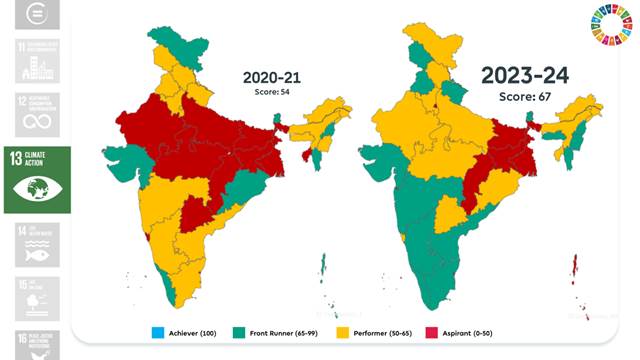
- Drastic improvement of 13 points in overall composite score of Goal 13 from 54 (Performer category) in SDG India Index 3 (2020-21) to 67 (Front Runner category) in the SDG India Index 2024 (2023-24)
- Disaster preparedness score as per Disaster Resilience Index stands at 19.20
- Improvement in electricity generation from renewable energy from 36.37% in 2020 to 43.28% in 2024
- 94.86% of industries comply with environmental standards
Goal 15 – Life on Land
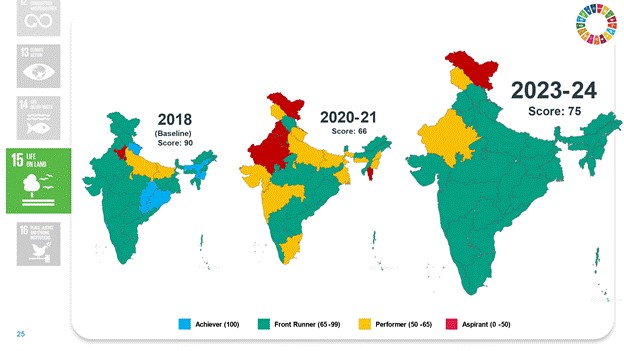
The score increased from 66 in Index 3 (2020-21) to 75 in Index 4 (2023-24). The number of States/UTs in Front Runner category increased from 17 in 2020-21 to 32 in 2023-24(SDG India Index 2024).
- Nearly 25% geographical area under forests and tree cover – as per India State of Forest Report 2021.
- 1.11% increase in carbon stock in forest cover – as per India State of Forest Report 2021.
Goal 16 – Peace, Justice and Strong Institutions
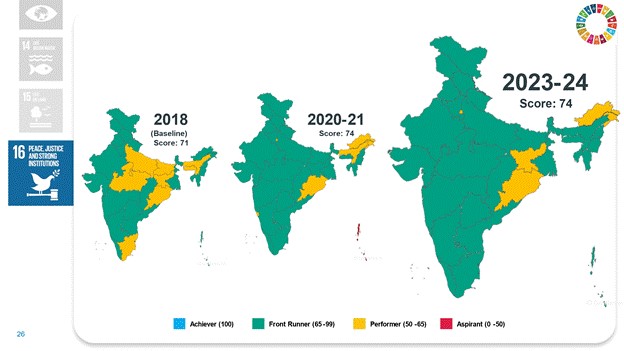
- 95.5% of the population is under Aadhaar coverage as of March 2024.
- 89% of births registered of children under five years as per NFHS-5 (2019-21)
- 71.3% charge sheeting rate of IPC crimes as per NCRB 2022.
Data and source from: PIB India
For all latest updates on Education and Jobs do follow us on Telegram here

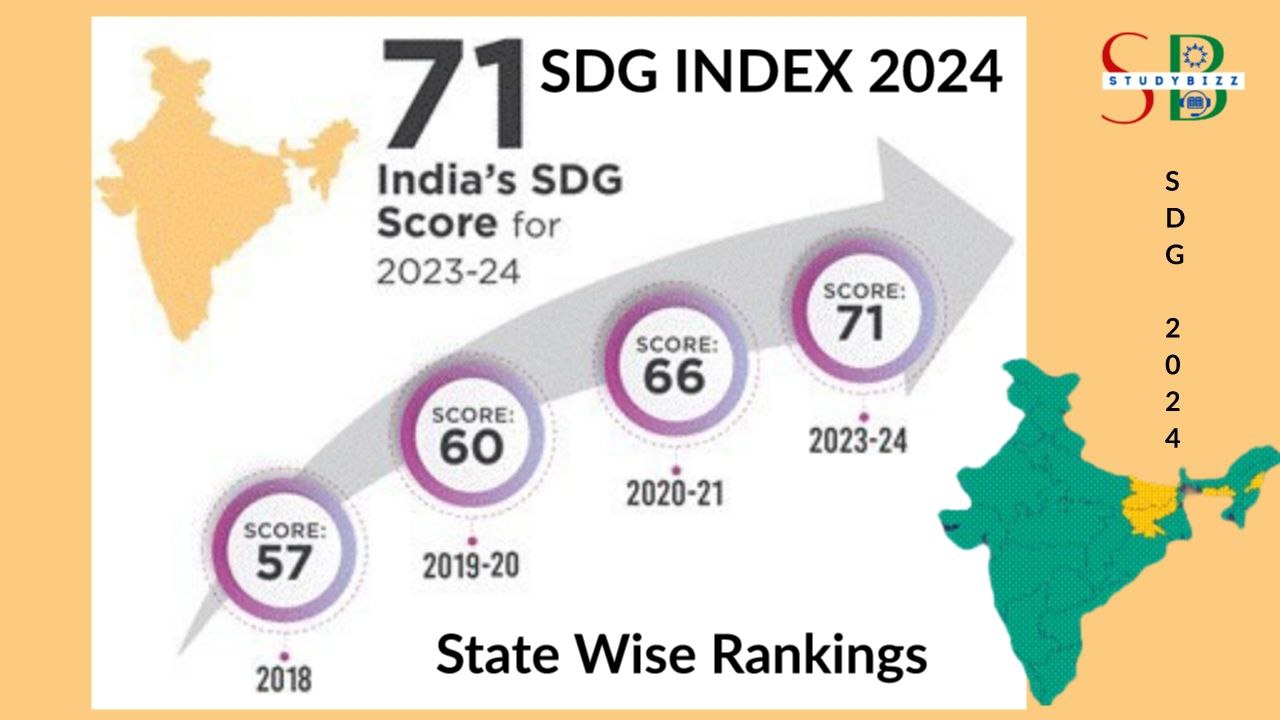
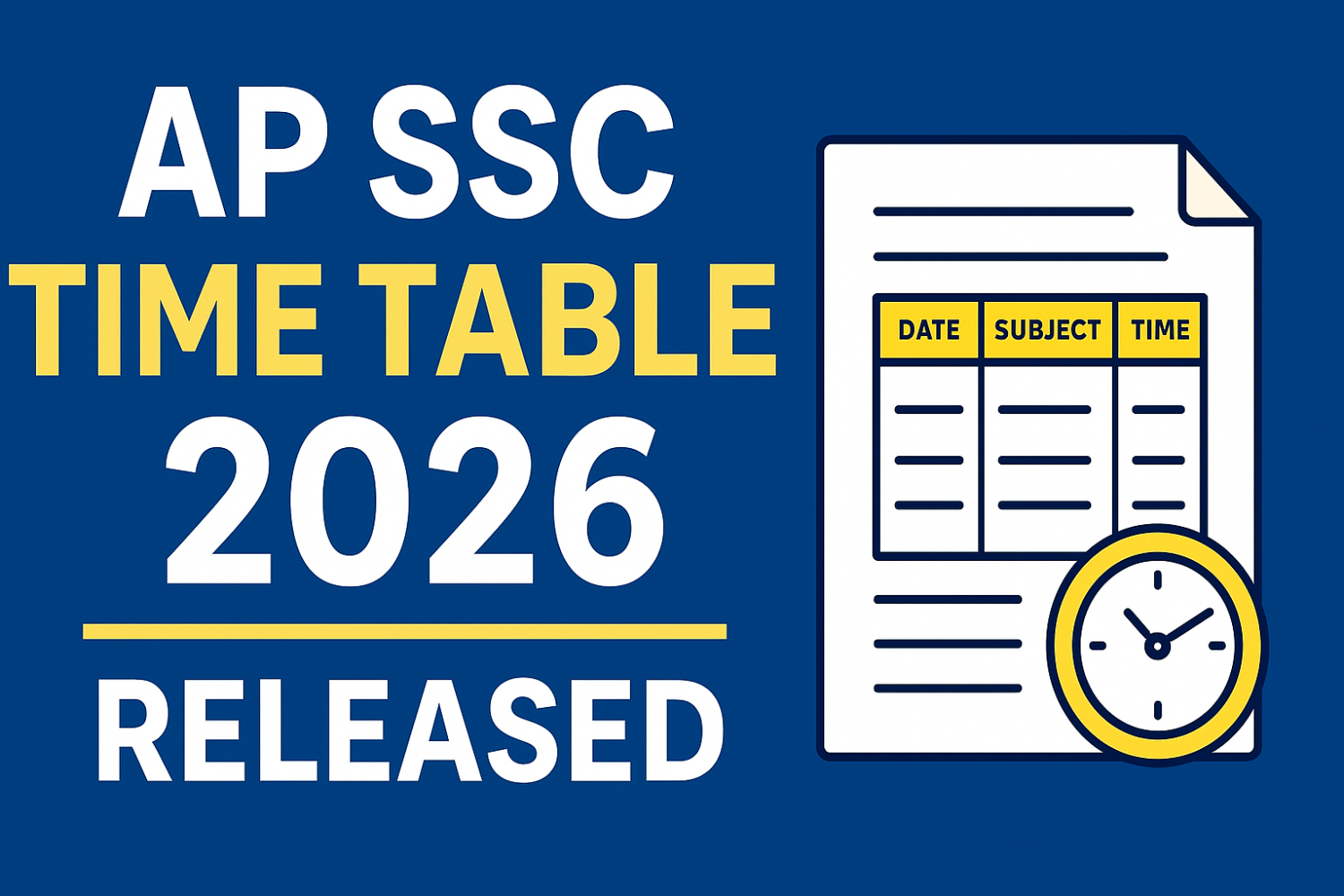
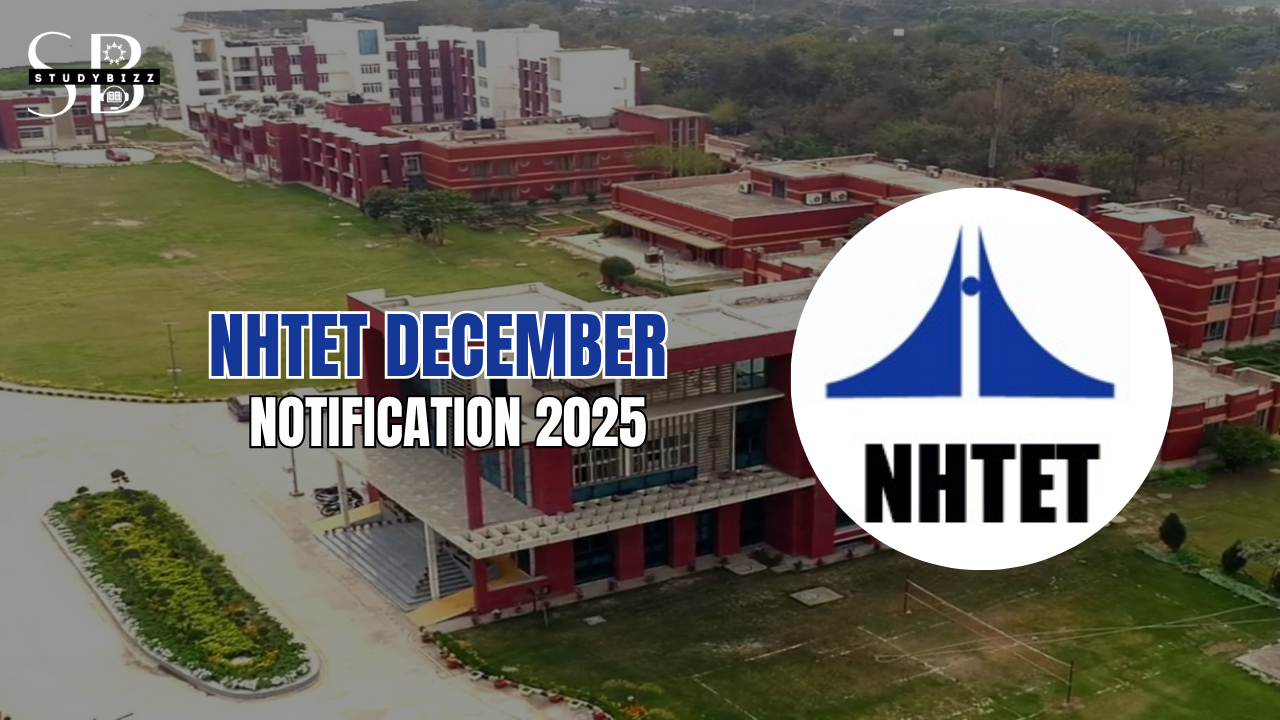
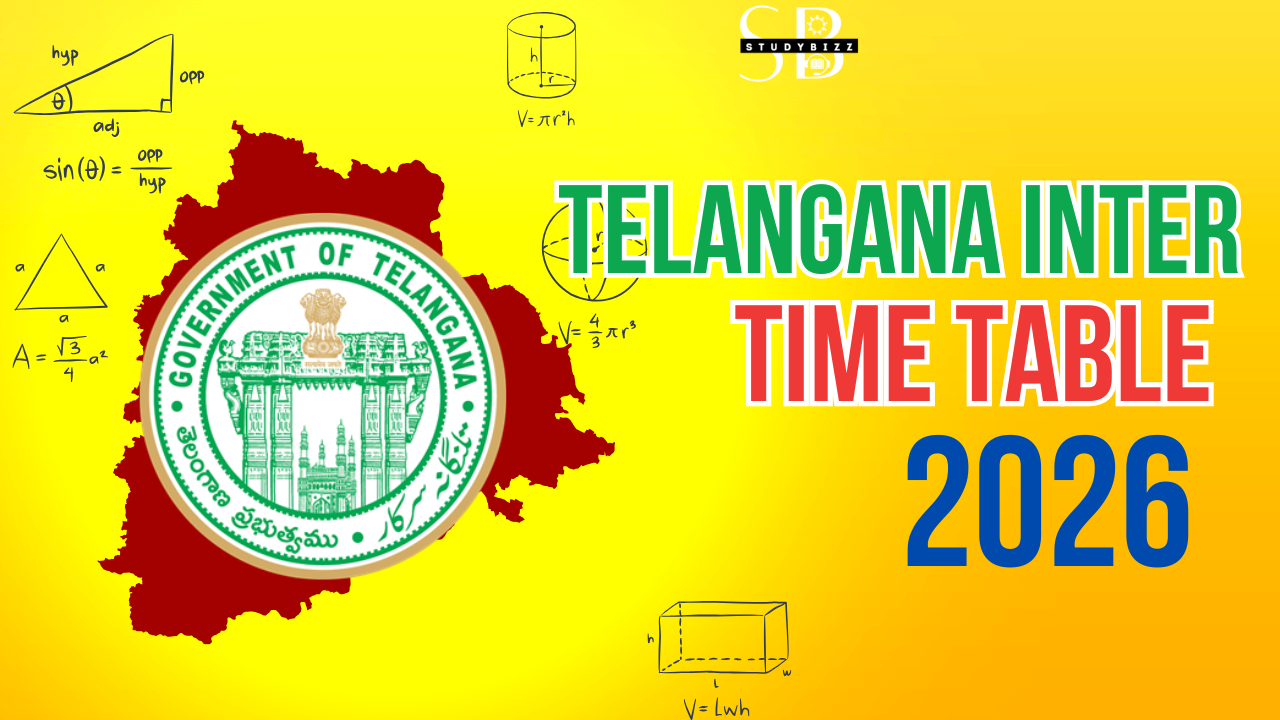
Leave a Reply